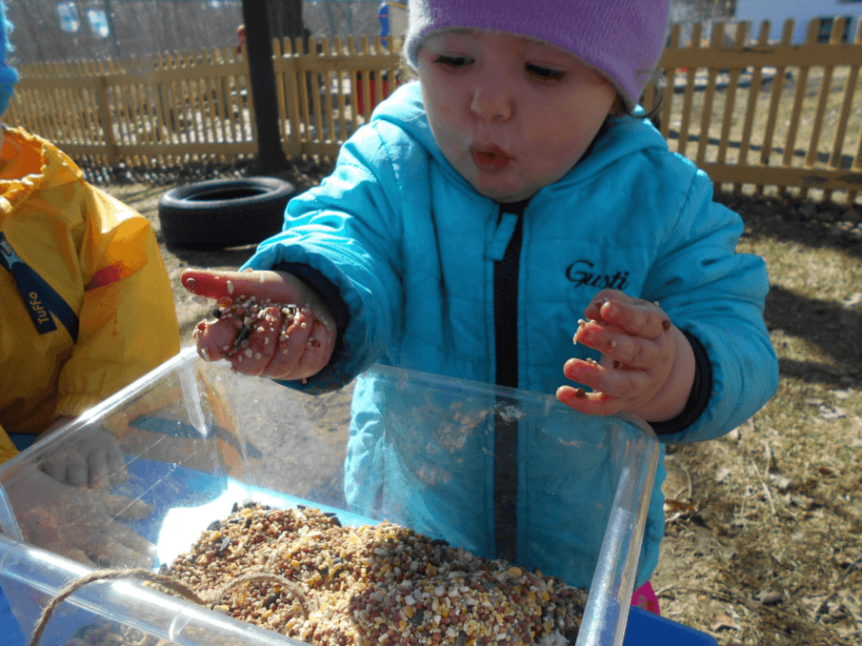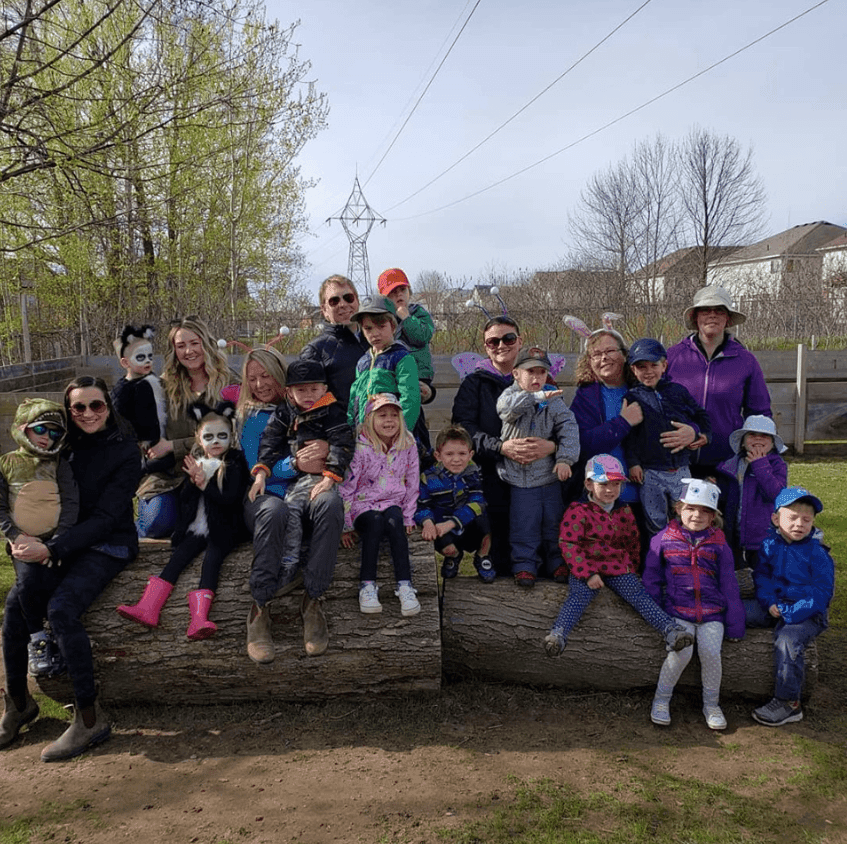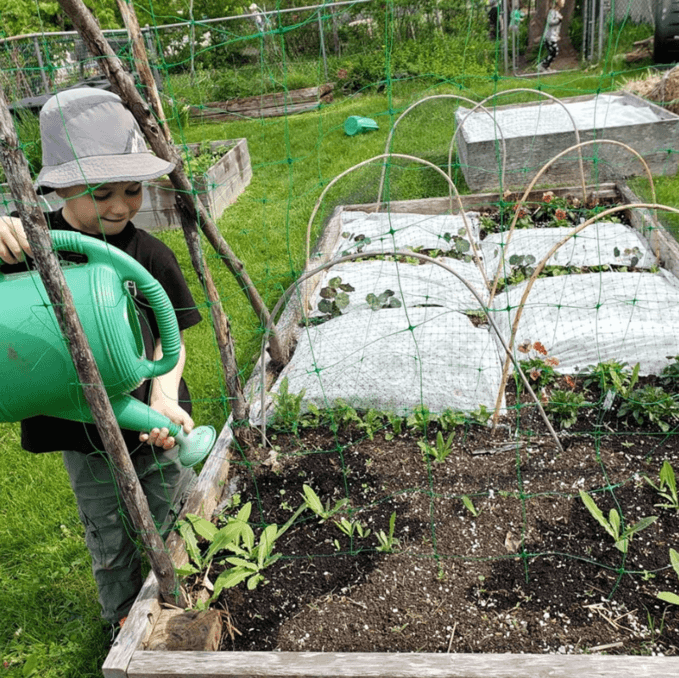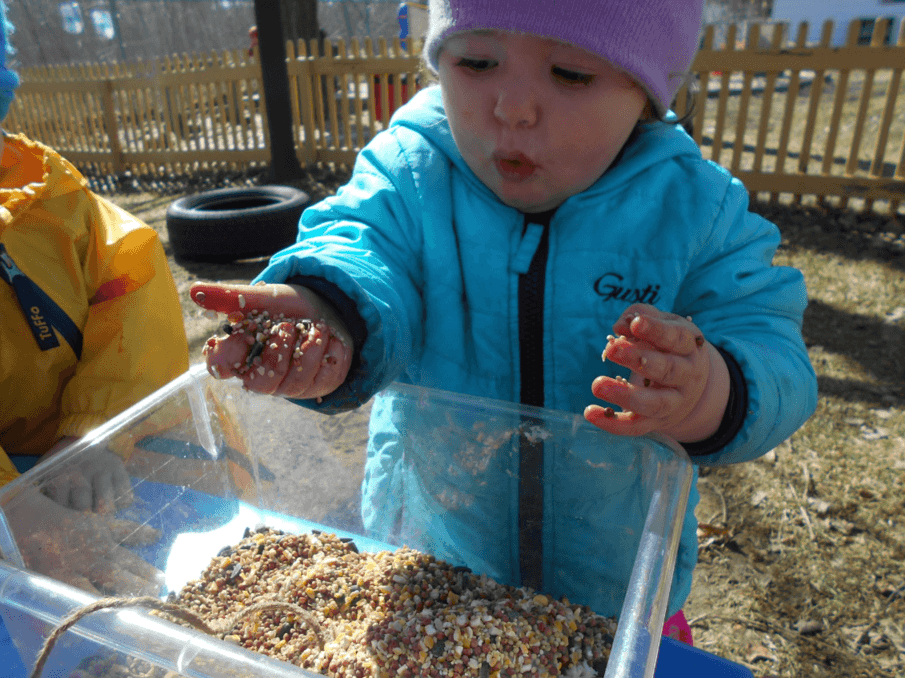Spring has sprung! Watching the transitional period of all the wildlife and plant life became a focus for all the children in May. From small buds and seeds into blossoming trees and flowers, May was full of growth!
We’ve had a very tactile month exploring the returning bird populations, creating paper mache, and being involved in charitable events. Let’s head into this months highlights!
Exploring birds in the infant room
For the last few weeks our brilliant infants have been exploring birds. As we use field guides and study our surroundings, they have noticed things in our environment such as different bird sounds, what birds need for a nest and what they eat as we created bird feeders.
We have also explored where the birds are located using our binoculars on bird walks through the school age forest. Here are a few pictures summarizing our journey through bird exploration! We are not done yet, we would love to invite you to come inside our classroom to see the detailed documentation around these incredible child-lead experiences.
Planting for summer and walking for the Hospital for Sick Children
Working hard in our garden! Watering, weeding and of course tasting! We planted our warm loving veggies this month and are excited to watch them grow. Be sure to check in with our gardening updates online!
We also held a Walkathon for Hospital for Sick Children and a Teddy Bear Picnic which were a huge success! Thank you to all the families who joined us and raised funds for the hospital.
It’s important for us to be involved in the community, and build a sense of charity and volunteerism early on for the children. Making community events fun is a great way to get the kids involved!
The wonderful world of bugs!
The Kinders have been bug crazy over the last couple of weeks. With the warmer weather, the bugs and insects have come out of hiding which has kept us very busy searching and learning about some of the bugs we have found.
Our friend E.S. brought in a big book all about different kinds of bugs to share with her friends. We learned some pretty interesting facts about some of the bugs we have been finding; number of body parts, homes, enemies, etc.
We started our very own chart and wrote down some of our favourite ones. We are excited to continue our investigations of the special bugs we find. We have seen so many worms outside, especially after a nice rain. The children were collecting them in containers so we decided to make a special home for them and keep some right in our classroom. We brought in a little bit of mud and placed it into a terrarium. We added a bit of grass seed on top and the children placed the worms inside. We sprayed it with water to keep the soil wet. We added some special rocks, leaves and sticks the Kinders had found. We thought it would be a good home for a slug and snail that we had found as well so we put them in too. Chelsa put some lettuce in for them to eat and we make sure to give it a sprinkle of water every day. Pop into our classroom and have a look! E.N, L.S, I.W and H.G.C. used the wooden loose parts to make homes for bugs inside our classroom. They even made “bedrooms” within the house.
This got us thinking, that we could make a bug house and put it outside. We collected some sticks, hay, leaves and long grass and brought them inside. We set that out along with cardboard tubes and cups. The children got right to work filling the tubes with the items we had found. Once they were all full we attached them all together with a piece of twine. We took it outside and placed it in a tree so the bugs could live in there. Our friends keep checking on it to see if there are any bugs inside. It has been so fun exploring the wonderful world of bugs!!
The possibilities of rocks continue to evolve in the PS Room
The preschool children have continued to show an increased curiosity in the different ways to investigate, categorize, and create using rocks. We started by understanding the different ways children have relationships with rocks and their memories associated with rocks. C.K. shared how rocks in the water are always black and after collaborative discussions with her mom, we learned that she spends a lot of her free time at the waters in Georgian Bay. We continued to understand how the children categorize the rocks based on their properties and based on their own lived experiences. R.S. shared how rocks that are bumpy and rough are called diving rocks and how smooth rocks are called rubbing rocks.
After further discussion, we learned the emotional response from the children were happy and joyful when they were rubbing them. The children were very curious about the new ways that we could categorize them based on the knowledge of their friends. The children learned about the experiences of others and learned how to categorize the rocks based on size, weight, and colour. The children tested the rocks to determine which rocks were the best. We watched how they changed when they got wet. We tested how strong they were with the wind and ribbon on Thursday. The children hypothesized if the rocks would fly away or if they would stay still. We determined that the larger the rock, the harder it was to move with the wind.
Later, the children used the rocks to create structures and this led into a conversation about Inukshuks. We learned about different kinds of Inukshuks and their meanings. A cool fun fact is that the world’s largest Inukshuk is in Schomburg, Ontario and only 40 minutes away! We are curious if anyone has ever visited it?
Where do chipmunks live? (PS2)
This month the preschool-2 class has been investigating chipmunks and where they live. This all started because BR saw a chipmunk run into a hole in the ground and he got excited! The children were curious about what chipmunks keep inside of their holes. When we came back inside, I set up coffee filters, bird seeds, pinecones, string and glue as an invitation to think about what a chipmunk nest might look like.
The next day we did some research using books. We learned that chipmunks own ½ an acre of land and they have burrows all over them that could be up to 30 feet long! The next day the children saw the chipmunk again, it ran under the oven in the Mud Kitchen. Off we went to see if we could find the hole it went into; this gave me the idea that we take the preschool class around the different yards to look for any other holes the chipmunks have made. We found two more in the mud kitchen and one in the school age yard. The children were happy to find the holes, however when we went to investigate further, they noticed a lot of worms and became fascinated with these little creatures! We will continue our investigation with chipmunks over the upcoming weeks, but we will also provide the opportunity for our children to explore the wonderful world of worms!
May your June be full of life and adventure! We’ve got tons of events and activities already planned for next month. Be sure to check out our Intro to Forest School Workshop on June 22nd. This is an outdoor, experiential workshop for everyone interested in learning more about the theory and practice of Forest and Nature School (FNS). This workshop is especially recommended for those who want to learn more about FNS prior to committing to our year-long Practitioners Course.
We will also be holding our Discovery FUN Fair June 25th, so be sure to sign-up and follow us on Facebook for updates and rain-date information. We will see you in June!







